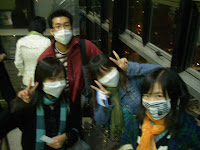

After learning so much about the Korean war from my history lessons and the visit to the War Memorial of Korea, we finally had the chance to visit the Joint Security Area and Demilitarized Zone to experience for ourselves. We were really looking forward to the tour as we've heard so much about the place. The tour is organized by the US Army and there are many rules and regulations, for example Korean nationals (except military personnels) are prohibited from visiting; people from Mainland China, Taiwan, Macau or Hong Kong have to apply for permission to visit; photography is restricted to certain areas and there are strict dress codes imposed as well. And here are some snaps on route to Camp Bonafas.
 At Camp Bonafas, our guide (a US army personnel) gave us a brief introduction of the history and places we were visiting, followed by the distribution of our UN guest tags which had to be pinned on our left collars at all times in the area. We also had to sign a declaration form indicating we would not hold them responsible should any accident happen to us.
At Camp Bonafas, our guide (a US army personnel) gave us a brief introduction of the history and places we were visiting, followed by the distribution of our UN guest tags which had to be pinned on our left collars at all times in the area. We also had to sign a declaration form indicating we would not hold them responsible should any accident happen to us.


Behind us is North Korea, which is mostly a yellow patch. We could use binoculars to look more closely and I saw houses and factories in the sparse land. There is no handphone signal and other forms of transmission of information such as radio and other signals near the area and within North Korea as the governent controls the transmission of information. And here's a viewing post of the North Korean soldiers. All our actions were closely monitored by them as well.
This is called The Bridge of No Return. After the ceasefire (Korea is technically still at war), soldiers from both sides could choose which Korea they want to go to. Once they have decided which side to go, they cannot revoke their decisions, and hence the name of the bridge was coined.

And this is the famous Panmunjeon, which is the meeting place for North and South Korea officials, and with the UN officials as well. Soldiers from both sides stand guard inside the blue buildings and photography with them is allowed. However, we are not allowed to touch/speak/gesture to them. Inside one of the pictures are our guide and our professor. Our professor's full time job is the chief negogiator for the US Army with the North Korean side and he teaches Korean War in our school as well.



We also visited Tunnel 3, which was a tunnel dug by North Korea to infiltrate into the South and was discovered subsequently. Photography was prohibited in the tunnel. And a last picture which I found interesting to end off this post. It shows the North Korean propaganda for its soldiers at the JSA. It was overall a great experience, there were so much to see and was definitely worth the visit.








